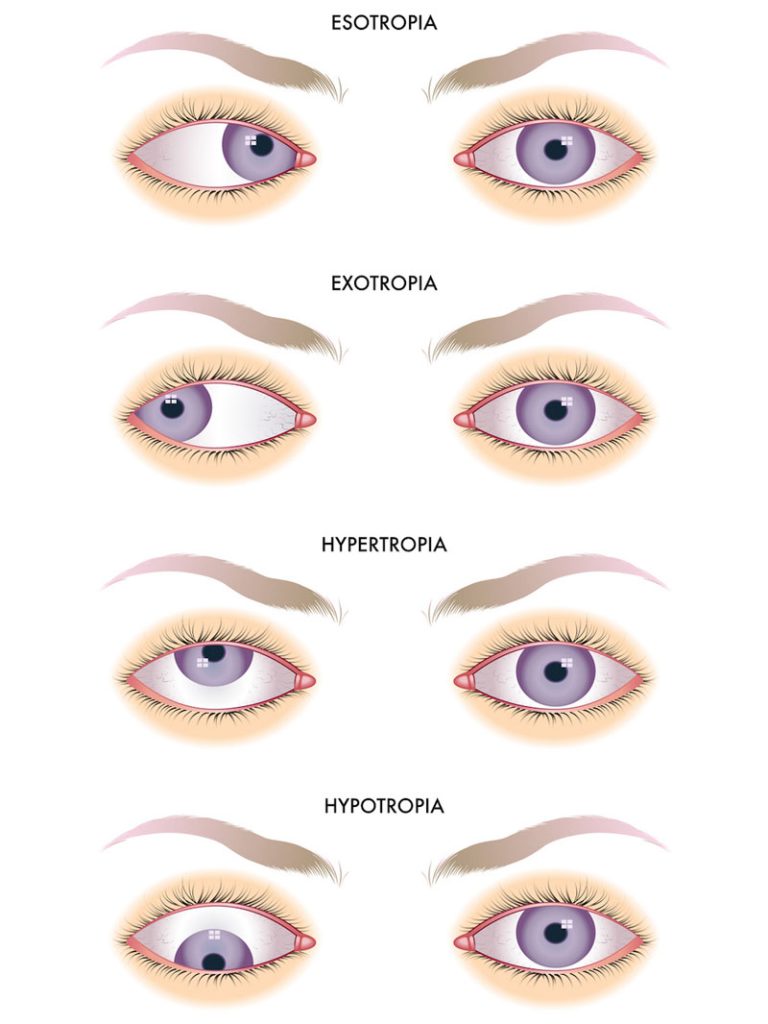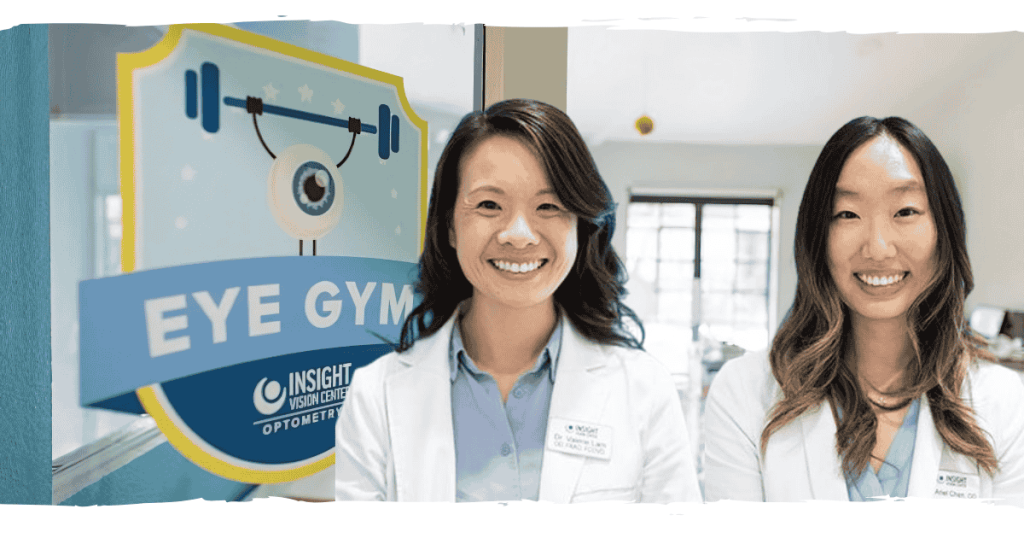Hypotropia is a specific type of strabismus, commonly referred to as vertical strabismus, where one eye is misaligned and turns downward relative to the other eye. This misalignment impacts both visual function and emotional well-being.
Hypotropia is less common compared to other types of strabismus, such as esotropia (inward turning) and exotropia (outward turning).
This misalignment not only alters the aesthetics of the eyes but can also disrupt visual perception. Patients may experience a range of symptoms, from the obvious cosmetic appearance of a drooping eye to more debilitating issues like diplopia (double vision), difficulty with depth perception, and challenges in visual coordination. The eyes may struggle to work together effectively, which can lead to headaches, issues with reading, and balance problems.
Signs and Symptoms of Hypotropia
Common Symptoms
- Visible Eye Misalignment: One eye appears to gaze downward while the other looks straight ahead.
- Double Vision (Diplopia): Images may appear “stacked” vertically, causing difficulty in focusing on tasks like reading or playing sports.
- Frequent Squinting or Closing One Eye: To reduce double vision or visual confusion during activities.
- Difficulty with Depth Perception: Challenges in judging distances, which can affect balance and coordination.
- Balance Issues: Increased tendency to bump into objects due to misjudged spatial awareness.
- Headaches or Eye Strain: Discomfort, especially during prolonged visual tasks that require focus.
- Reading Difficulties: Challenges with reading fluency and comprehension, impacting academic performance.
Impact on Daily Life
- Academic Challenges: Difficulty with reading, writing, and concentrating can hinder educational progress.
- Social Interaction: Misalignment may lead to self-consciousness, reduced confidence, and social withdrawal.
- Physical Safety: Risks during activities like sports or navigating crowded spaces due to impaired depth perception.
- Emotional Well-being: Frustration, anxiety, and behavioral issues stemming from vision problems.
Visual Perceptual Issues
- Suppression of the Affected Eye: The brain may ignore input from the deviated eye to eliminate double vision, leading to amblyopia (lazy eye) and reduced depth perception.
- Visual Confusion: Difficulty in processing differing images from each eye, causing disorientation.
- Dependence on One Eye: Relying on the non-affected eye can weaken the turned eye further.
- Reading Challenges: Visual distractions can make it hard to focus, leading to a loss of interest in learning.
If you notice these symptoms in yourself or your child, early intervention is crucial. Untreated hypotropia can lead to lifelong vision difficulties, including amblyopia. Seeking evaluation and treatment can significantly improve visual function and enhance quality of life.
The Difference Between Horizontal and Vertical Strabismus
The key distinction between horizontal and vertical strabismus lies in the direction the eyes turn. While horizontal strabismus includes inward or outward turning (esotropia and exotropia), vertical strabismus, which includes conditions like hypotropia and hypertropia, is characterized by an upward or downward deviation.
Understanding these differences is fundamental not only for accurate diagnosis but also for appropriate treatment strategies. Both forms of strabismus can arise from similar underlying issues, including muscular imbalances, refractive errors like significant hyperopia, and neurological challenges. For instance, children with high levels of uncorrected hyperopia may find themselves over-focusing, leading to a tendency toward esotropia, while those with hypotropia may have difficulty maintaining proper alignment due to other issues.
The Importance of A Developmental Eye Exam
Detecting and diagnosing hypotropia involves a series of specialized tests, that are not done in a routine eye exam. A developmental or functional eye exam, which takes around one hour, is designed to evaluate how well the eyes are aligned and how they work together. Early diagnosis is crucial to prevent vision complications such as amblyopia (lazy eye), which can develop when the brain begins to ignore the misaligned eye.
Some examples of the testing performed includes:
- Hirschberg Test: Assesses alignment by checking corneal light reflex.
- Cover/Uncover Test: Identifies eye movement and alignment issues.
- Krimsky Test: Uses prisms to quantify the amount of deviation.
- Simultaneous Prism Cover Test: Measures the degree of strabismus while allowing both eyes to view the target.
- Worth Four Dot: A clinical test to assess how the eyes work together as a team
Once diagnosed based on a combination of these tests, treatment options can be discussed to help correct the alignment of the eyes and mitigate any effects on visual development.
Conveniently situated in Costa Mesa, we attract patients from across Orange County, including Irvine, Huntington Beach, and Santa Ana, for advanced vision therapy treatment.
Causes and Risk Factors
Underlying Causes of Hypotropia
It typically arises from issues related to the eye muscles, nerves, or neurological functions that direct eye movement. The deviation may be constant or intermittent, meaning it can occur continuously or only under certain conditions, such as fatigue or after extensive close work.
In children, it is often linked to significant uncorrected hyperopia (farsightedness), which forces the eyes to strain while trying to focus, consequently leading to misalignment.
Several factors may increase the likelihood of developing hypotropia. A family history of strabismus or related eye conditions can significantly raise the risk. Beyond genetics, environmental influences, including maternal health factors during pregnancy such as smoking or preterm birth, can contribute to the development of this condition. Excessive screen time and insufficient visual breaks may further exacerbate underlying eye issues in children.
Associated Health Conditions
Hypotropia is often seen in broader contexts of health where other conditions like cerebral palsy, Down syndrome, and head trauma can contribute to strabismus. Children diagnosed with these health conditions frequently face a greater chance of encountering visual misalignments, including hypotropia. Furthermore, if untreated, hypotropia could lead to amblyopia, where the brain begins to ignore the visual input from the affected eye, potentially leading to further vision impairment.
Comparing Similar Eye Conditions
Differences Between Hypotropia and Other Types of Strabismus
Unlike esotropia, which involves an inward turning of the eye, or hypertropia, where the eye turns upward, hypotropia manifests with a unique set of symptoms and challenges.
It’s not uncommon for hypotropia to coexist with other forms of strabismus, and symptoms can sometimes overlap. Parents may notice that their child has difficulty with depth perception, experiences double vision, or frequently bumps into objects.

Understanding the Variations in Strabismus
Strabismus encompasses various types, classified by the direction and frequency of eye turns. It’s critical to differentiate among:
- Esotropia: Inward turning of the eye.
- Exotropia: Outward turning of the eye.
- Hypertropia: Upward turning of the eye.
- Hypotropia: Downward turning of the eye.
Each condition may present unique symptoms and can have distinct implications for the visual development of affected individuals, especially children. Among the symptoms of hypotropia are double vision, visual confusion, and suppression, wherein the brain ignores input from the deviating eye to avoid diplopia (seeing double).
Top Pediatric Eye Specialists in Orange County
At Insight Vision Center Optometry, Dr. Valerie Lam and Dr. Ariel Chen lead our pediatric eye care team, specializing in the treatment of hypotropia and providing comprehensive vision therapy for children throughout Orange County. With advanced training in developmental vision, our pediatric doctors offer tailored services, including thorough pediatric eye exams, personalized vision therapy programs, and targeted treatments for eye misalignment conditions like hypotropia. Families across Orange County trust us for our compassionate approach, expert knowledge, cutting-edge technology, and child-friendly environment, ensuring each child receives the best possible care to enhance their visual health and overall development.
How is Hypotropia Treated?
Treatment varies based on age, severity, and individual needs. Here are some options:
For Infants and Young Children
- Eyeglasses or Contact Lenses: Corrective lenses can address refractive errors, helping to align vision.
- Vision Therapy: Customized activities enhance eye coordination and focusing skills, conducted both at home and in the office.
For School-Aged Children and Teens
- Prism Lenses: Special lenses that alter light entering the eye, reducing the downward turn and easing visual strain.
- Comprehensive Vision Therapy: One-on-one sessions focusing on improving visual processing and coordination.
For Older Adolescents and Adults
- Comprehensive Vision Therapy: In less severe cases patients may benefit from vision therapy prior to surgery which may delay or in some cases even prevent the need for surgery.
- Surgery: If other treatments aren’t effective, surgery may realign the eye. Post-surgical vision therapy often helps restore full visual function by helping the post surgical eye reintegrate into the binocular system.
Vision Therapy Programs
Vision therapy aims to improve coordination and visual skills through customized exercises suitable for all ages.
- Targeted Exercises: Activities to enhance eye teaming, focusing, and tracking.
- Home reinforcement: Exercises to reinforce skills learned during therapy sessions.
- Ongoing Assessment: Regular evaluations to track progress and adjust treatments.
Patients often experience significant improvements in vision and quality of life with commitment to vision therapy.

Advanced Treatment Techniques
Surgical Interventions
Surgery adjusts the eye muscles to realign the deviated eye when non-surgical treatments aren’t sufficient. Surgical intervention has a success rate of approximately 80% to 90% in achieving proper eye alignment.
- Advantages:
- Quick alignment leading to improved appearance.
- Reduction in double vision and related symptoms.
- Potential restoration of binocular vision.
- Disadvantages:
- Risks like infection and anesthesia complications.
- Possible need for additional surgeries.
- May not address all visual issues without additional therapies.
- May not fully reintegrate binocular vision without therapy
Surgery Combined with Vision Therapy
Combining surgery with vision therapy often yields the best results. Post-surgical vision therapy helps:
- Enhance Eye Coordination: Reinforces proper muscle function.
- Improve Binocular Vision: Encourages both eyes to work together.
- Address Residual Issues: Tackles any remaining visual challenges.

Expert Hypotropia Treatment and Vision Therapy for Orange County Kids
Insight Vision Center Optometry, located in Costa Mesa, provides top-tier care for children with hypotropia in Orange County. Dr. Valerie Lam and Dr. Ariel Chen lead our pediatric vision therapy program, specializing in correcting eye misalignment and enhancing visual skills through tailored therapy programs. Serving families from Irvine, Huntington Beach, and Santa Ana, we are dedicated to helping children achieve optimal vision and succeed academically. Our compassionate approach and cutting-edge technology ensure each child receives the personalized treatment they need. Book your child’s vision therapy appointment today by calling (714) 942-1361 or book online.





